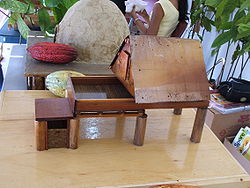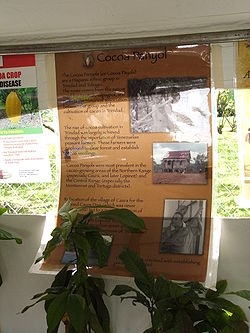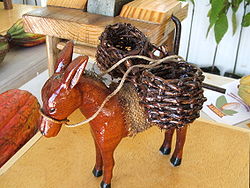
Cocoa Panyol
Encyclopedia
The Cocoa Panyols are an ethnic group in Trinidad & Tobago. The name comes from the patois
word for Spanish
, espagnol, or even Spanish
word Español and reflects the historical association between the group and the cultivation of cacao in Trinidad
(Cocoa Español).


 This community in Trinidad originated in the late sixteenth century (see History of Trinidad and Tobago
This community in Trinidad originated in the late sixteenth century (see History of Trinidad and Tobago
). After the island fell under British
control in 1797, Spanish-speaking Venezuelan
s continued to settle in Trinidad, usually in connection with the civil wars and revolutions which followed the Bolivarian
revolution. The rise of cocoa cultivation in Trinidad was largely achieved through the importation of Venezuelan peasant farmers. These farmers were employed to clear forest and establish cocoa seedlings. After five or seven years they were paid for each mature cocoa tree on the plot of land. They then moved on to a new plot of land. They are also credited with establishing Parang
in Trinidad. The Cocoa Panyols are an ethnic mixture of mainly Amerindian and African ancestry.
Cocoa Panyols were most prevalent in the cacao-growing areas of the Northern Range
(Caura, Lopinot, Arima, Santa Cruz and Maraval) and the Central Range (especially the Montserrat and Tortuga districts). Relocation of the village of Caura for the planned Caura Dam (which was never constructed) led to a major disruption of Cocoa Panyol society. Many families re-located to the Lopinot Valley, but others moved into urban areas and were absorbed into the mainstream of Trinidadian life. In modern multi-ethnic Trinidadian society the Cocoa Panyols are sometimes seen as a vanishing minority. Many Cocoa Panyols merged into the French Creole, Indo-Trinidadian and Afro-Trinidadian communities through intermarriage. In the Paramin Region of Maraval, in the Northern Range, some Cocoa Panyols became integrated into the Patois-speaking communities, giving rise to the Parang tradition in Paramin and the blend of Venezuelan and French Creole cultures.
The term Spanish is sometimes used synonymously with Cocoa Panyol, but may also be used for Venezuela
ns, Colombia
ns, or other Hispanic national groups. This term is used as a reference to the language and not the actual race/ethnicity of the Cocoa Panyols.
French-based creole languages
A French Creole, or French-based Creole language, is a creole language based on the French language, more specifically on a 17th century koiné French extant in Paris, the French Atlantic harbors, and the nascent French colonies...
word for Spanish
Spanish people
The Spanish are citizens of the Kingdom of Spain. Within Spain, there are also a number of vigorous nationalisms and regionalisms, reflecting the country's complex history....
, espagnol, or even Spanish
Spanish language
Spanish , also known as Castilian , is a Romance language in the Ibero-Romance group that evolved from several languages and dialects in central-northern Iberia around the 9th century and gradually spread with the expansion of the Kingdom of Castile into central and southern Iberia during the...
word Español and reflects the historical association between the group and the cultivation of cacao in Trinidad
Trinidad
Trinidad is the larger and more populous of the two major islands and numerous landforms which make up the island nation of Trinidad and Tobago. It is the southernmost island in the Caribbean and lies just off the northeastern coast of Venezuela. With an area of it is also the fifth largest in...
(Cocoa Español).



History of Trinidad and Tobago
The history of Trinidad begins with the settlements of the islands by Amerindians. Both islands were explored by Christopher Columbus on his third voyage in 1498. Tobago changed hands between the British, French, Dutch and Courlanders, but eventually ended up in British hands. Trinidad remained in...
). After the island fell under British
United Kingdom
The United Kingdom of Great Britain and Northern IrelandIn the United Kingdom and Dependencies, other languages have been officially recognised as legitimate autochthonous languages under the European Charter for Regional or Minority Languages...
control in 1797, Spanish-speaking Venezuelan
Venezuelan people
Venezuelan people are from a multiethnic nation in South America called Venezuela. Venezuelans are predominantly Roman Catholic and speak Spanish, and a majority of them are the result of a mixture of Europeans, Africans, and Amerindians.-Demography:...
s continued to settle in Trinidad, usually in connection with the civil wars and revolutions which followed the Bolivarian
Simón Bolívar
Simón José Antonio de la Santísima Trinidad Bolívar y Palacios Ponte y Yeiter, commonly known as Simón Bolívar was a Venezuelan military and political leader...
revolution. The rise of cocoa cultivation in Trinidad was largely achieved through the importation of Venezuelan peasant farmers. These farmers were employed to clear forest and establish cocoa seedlings. After five or seven years they were paid for each mature cocoa tree on the plot of land. They then moved on to a new plot of land. They are also credited with establishing Parang
Parang
Parang is a popular folk music originating out of Trinidad and Tobago, it was brought to Trinidad by Venezuelan migrants who were primarily of Amerindian and African heritage, something which is strongly reflected in the music itself. The word is derived from two Spanish words:'Parranda', meaning...
in Trinidad. The Cocoa Panyols are an ethnic mixture of mainly Amerindian and African ancestry.
Cocoa Panyols were most prevalent in the cacao-growing areas of the Northern Range
Northern Range
The Northern Range is the range of tall hills across the northern portion of Trinidad, the major island in the Republic of Trinidad and Tobago. The hills rise abruptly from the lowlands of northern Trinidad , but only the two tallest peaks, El Cerro del Aripo and El Tucuche top 900 m...
(Caura, Lopinot, Arima, Santa Cruz and Maraval) and the Central Range (especially the Montserrat and Tortuga districts). Relocation of the village of Caura for the planned Caura Dam (which was never constructed) led to a major disruption of Cocoa Panyol society. Many families re-located to the Lopinot Valley, but others moved into urban areas and were absorbed into the mainstream of Trinidadian life. In modern multi-ethnic Trinidadian society the Cocoa Panyols are sometimes seen as a vanishing minority. Many Cocoa Panyols merged into the French Creole, Indo-Trinidadian and Afro-Trinidadian communities through intermarriage. In the Paramin Region of Maraval, in the Northern Range, some Cocoa Panyols became integrated into the Patois-speaking communities, giving rise to the Parang tradition in Paramin and the blend of Venezuelan and French Creole cultures.
The term Spanish is sometimes used synonymously with Cocoa Panyol, but may also be used for Venezuela
Venezuela
Venezuela , officially called the Bolivarian Republic of Venezuela , is a tropical country on the northern coast of South America. It borders Colombia to the west, Guyana to the east, and Brazil to the south...
ns, Colombia
Colombia
Colombia, officially the Republic of Colombia , is a unitary constitutional republic comprising thirty-two departments. The country is located in northwestern South America, bordered to the east by Venezuela and Brazil; to the south by Ecuador and Peru; to the north by the Caribbean Sea; to the...
ns, or other Hispanic national groups. This term is used as a reference to the language and not the actual race/ethnicity of the Cocoa Panyols.

